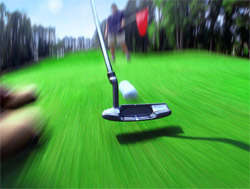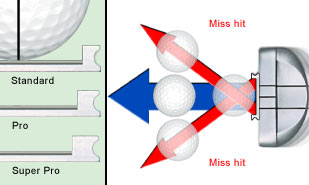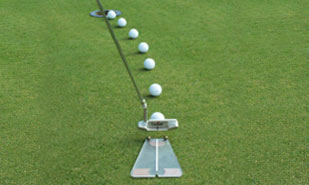 For amateurs, putting makes up between half and one-third of all strokes on a golf course. If you can lower the amount of putts you take by only 10%, that’s a three- to four-shot improvement.
For amateurs, putting makes up between half and one-third of all strokes on a golf course. If you can lower the amount of putts you take by only 10%, that’s a three- to four-shot improvement.
Yet visit any golf course, and you’ll likely not see many people practicing their putting despite the obvious importance.
I used to neglect putting, but I’ve since served penance to the golf gods and am starting to get the ball to the hole a lot better than I used to. To me, putting boils down to a few basic ideas: stroke, aim, and confidence. You can make huge steps towards dropping strokes off your scorecard by practicing these three things. Read on to see how I’m doing it.
Stroke
 For work on my stroke I use one of Dave Pelz’s many teaching devices – the Teacher Putting Clips. These metal clips stick to the putter face and restrict the area with which you can strike the ball. The clips come in a pack with three sizes: Standard, Pro, and Super Pro. The Super Pro size allows for about 1/8th of an inch of leeway on either side of the ball and makes for very challenging putting exercises.
For work on my stroke I use one of Dave Pelz’s many teaching devices – the Teacher Putting Clips. These metal clips stick to the putter face and restrict the area with which you can strike the ball. The clips come in a pack with three sizes: Standard, Pro, and Super Pro. The Super Pro size allows for about 1/8th of an inch of leeway on either side of the ball and makes for very challenging putting exercises.
For added visual and mental effect I use this Pelz product in conjunction with a Never Compromise Stubby putter – this helps narrow my focus and gets my body ready to roll the putt. Since the greens around here are still bumpy to say the least I’ve been practicing in my basement using the Pelz Truthboard. This 3½ foot long strip of putting turf doesn’t add any difficulty to the exercise, yet allows me to roll the ball to a hole. My main drill using these three pieces of equipment is as simple as seeing how many putting I can roll in using the Super Pro clips – my record is 16 consecutively.
Aim
 Even if you have the perfect putting stroke it’ll do you no good if you don’t read the break properly and align yourself with the intended target line. Years ago, Putting Guru Pelz discovered that 100% of the people he tested under-read the break of their putts by nearly a factor of three! This is because when we golfers align ourselves to a putt we’ve read, we commonly use the apex of the break as the aiming point, but in reality, that point is nearly 1/3 of the total break.
Even if you have the perfect putting stroke it’ll do you no good if you don’t read the break properly and align yourself with the intended target line. Years ago, Putting Guru Pelz discovered that 100% of the people he tested under-read the break of their putts by nearly a factor of three! This is because when we golfers align ourselves to a putt we’ve read, we commonly use the apex of the break as the aiming point, but in reality, that point is nearly 1/3 of the total break.
Once we set up to this intended line, we subconsciously manipulate the putter to get the ball rolling on a line closer to that of the actual break. This causes severe inconsistency on the greens. Luckily, Pelz has a piece of equipment to help us out. Meet The Putting Tutor. Phil Mickelson, student of Pelz, uses this device to make sure he’s rolling the ball on the right line and it can help you, too.
Confidence
Golf is a game of confidence. If you look at a shot and think, “I’m gonna stick this one tight,” you probably will. The same holds true in putting. If you approach each putt as an opportunity to succeed rather than a probable mishap you’ll see more putts drop.
After working on my stoke and aim for a while I’ve seen myself rolling the ball much better and this has in turn bred confidence and trust in myself on the greens. Golf legend Jackie Burke Jr. is an advocate of the 100 putts drill- place six balls in a three foot circle around the hole and sink 100 consecutive putts before you quit. Phil Mickelson uses this drill to take a bit of the bite out of putts in the three to six foot range.
Conclusion
If you put a little effort into becoming a better putter, you will most definitely see shots come off your score. Like I said before, nearly half of all the strokes in an average round are had on the green, it just makes sense to put a little more effort into improving that area of your game and hopefully these tips will help you do just that.

I guess I don’t understand how the putting tutor can help you read the greens better. The first two thing I understand.
wow I’ve never experienced this before but that blurred picture freaks me out. It makes me dizzy like motion sickness or something. Wow.
Now I’m not sure any device can aid in reading greens because there can be many breaks depending on your ball speed….
There is a tool called Exelys Breakmaster which digitally tells you the break. Obviously as media guru mentioned there can be multiple breaks so you will have to work it all out in your head. The breakmaster obviously can only be used during practice and really helps you train your eyes to read what you are seeing. I included the link below.
http://www.golfsmith.com/products/237885
Mediaguru,
The putting tutor ensures a straight role along your aim/ target line, anything else would cause one of the marbles to dislodge. The preferred “break” to read and speed to use is the one that leaves your ball 17″ past the cup – the optimal speed for holing putts. Therefore the putting tutor is used to help identify and validate that the aimline you used to set up your putt is correct. Pelz is all about immediate feedback when practicing, which this device provides.
I originally purchased the putting tutor, which definitely helped with my ball striking and green reading. Where I had my problem was with my stroke in a pressure situation. If I found myself needing to sink a putt to stay ahead or gain a stroke, I found myself hitting the ball too hard. I then purchased Dave Pelz Putting Bible and incorporated the Pelz Pendilum swing. I no longer use my hands and forearms to power my putts, and I’m sinking more of those “pressure putts”. Thanks, Dave!